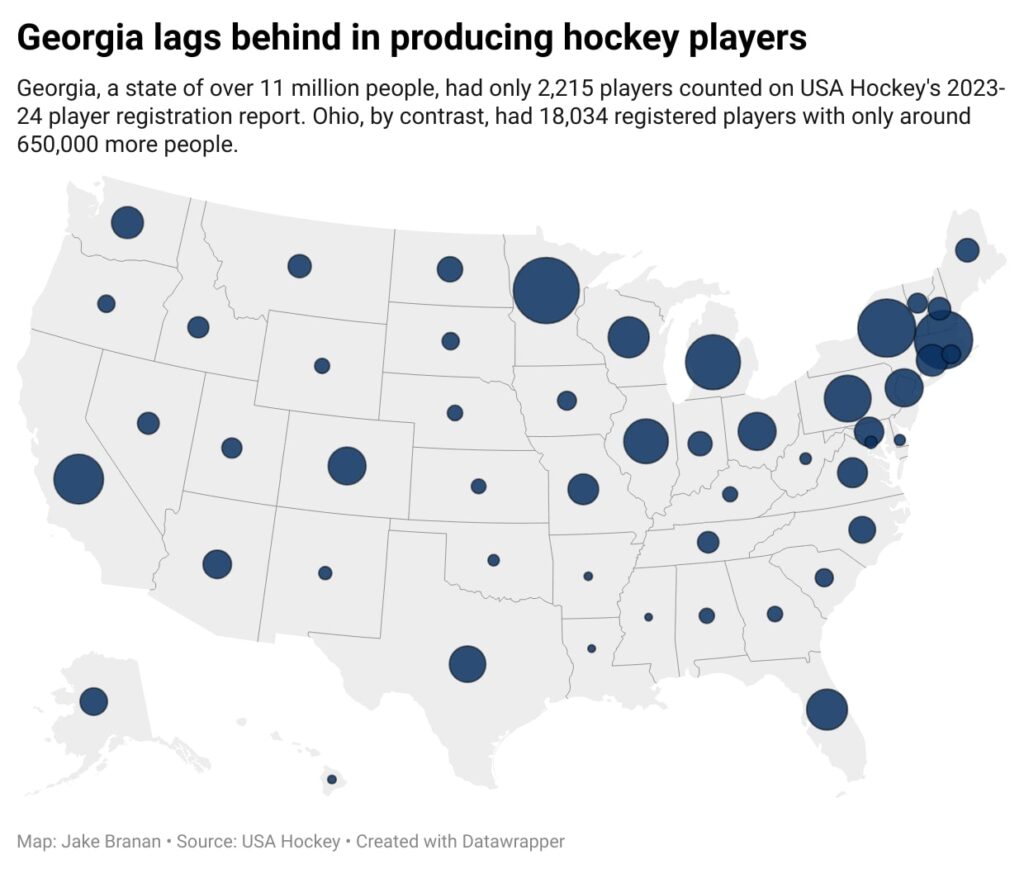Sports in Athens and its surrounding area are, and have always been, primarily associated with one thing: Georgia Bulldogs football. The University of Georgia’s Sanford Stadium welcomes over 90,000 football-crazed fans nearly every week no matter how the season is going, and the stadium towers over the rest of the UGA campus.
But while college football and sweltering summer heat dominate the area, there’s a much “cooler” sport emerging, both literally and figuratively, from the shadows of the football team that has never reached mainstream popularity in Georgia: ice hockey.
To say that hockey is entirely new to Athens is untrue; the exact opposite is actually the case.
The UGA men’s club hockey team, nicknamed the Ice Dawgs, was founded back in 1987. What is true is that hockey in Athens has historically served a very niche community. The Ice Dawgs have won four College Hockey South conference titles, but they struggle to receive nearly the level of attention a UGA varsity team would because that conference isn’t part of the NCAA.
Until this season, the Ice Dawgs played at a rink with barely 2,000 seats and so had previously been unable to generate much fan interest even if they were a varsity team.
The Ice Dawgs got a competitor for attention last year, but so far it’s been a blessing in disguise for Athens hockey: the Athens Rock Lobsters. The Rock Lobsters compete in the Federal Prospects Hockey League, a lower-level league that, while unaffiliated with the NHL, is still professional.
So far, the Rock Lobsters have been a success. They currently sit in first place out of seven teams in the FPHL’s Continental Division and second in the entire 14-team league, and they’ve already clinched a playoff spot in their debut season.
The Athens community has immediately embraced its new team, as the Rock Lobsters have welcomed over 97,000 fans through the gates in only 26 home games for an average attendance of 3,766 per game (as of April 2).
The Rock Lobsters have helped boost hockey’s popularity in Athens, but the arena they play in has also played an important role. The 8,500-seat Akins Ford Arena opened last December and plays host to both the Ice Dawgs and Lady Ice Dawgs (the women’s club team founded in 2021) in addition to the Rock Lobsters. Now, all three teams have a brand-new, purpose-built arena to attract large audiences and spread the game farther than has ever previously been possible in this region.
Why It’s Newsworthy: The Rock Lobsters have become an immediate success story, securing a playoff spot and filling a brand-new arena in their first season. In doing so, they’ve provided a professional alternative in an area dominated by college sports and, more important, potentially beginning the revitalization of Georgia’s hockey scene that has historically been close to nonexistent outside the Atlanta area.
Hockey’s newfound popularity in Athens could potentially revitalize the hockey culture in Georgia. Georgia has Atlanta to thank for most of its hockey pedigree. The city has had two NHL teams: the Flames from 1972-80 and the Thrashers from 1999-2011. Atlanta is currently only home to the Gladiators of the ECHL (formerly East Coast Hockey League), the NHL’s third-tier minor league and equivalent to Double-A in baseball.
Outside of the Atlanta area, however, hockey in Georgia has historically struggled to stay afloat. The Rock Lobsters are one of only four hockey teams in the entire state outside of Metro Atlanta that play at any sort of high level, along with their FPHL rivals the Columbus River Dragons, the ECHL’s Savannah Ghost Pirates and the SPHL (formerly Southern Professional Hockey League)’s Macon Mayhem. The addition of the Rock Lobsters has reenergized the niche hockey community at UGA that finally has a team to call its own.
“For the most part, over the years, I have not had many conversations with people about hockey,” said Jonathan Peters, the head of UGA’s journalism department and a longtime hockey fan and former player.
When the Rock Lobsters came around, a lot of people began dropping in on my office and saying, ‘Hey, I’ve got questions about hockey.’”
Peters found his love for the game growing up in Athens, Ohio. Ohio provides a convenient comparison to demonstrate the sparse hockey scene in Georgia that Athens is trying to rejuvenate. Per USA Hockey’s 2023-24 player registration report, Ohio had 18,034 players officially registered with the governing body while Georgia only had 2,215. This report doesn’t account for every hockey player in the country, but Ohio only has about 650,000 more people than Georgia according to Britannica’s 2023 estimate. Ohio would have almost 90 million people if population differences and registration differences were proportional.

The main way hockey in Georgia is somewhat comparable to hockey in Ohio is that both states have had two NHL teams; the Cleveland Barons existed briefly in the mid-1970s and the Columbus Blue Jackets have played in the league since 2000.
Where Ohio quickly begins to separate itself from Georgia is the presence of an established organized hockey pyramid. At the professional level, there’s already a major difference: the Blue Jackets have an affiliate in the American Hockey League, the primary minor league for the NHL, in the form of the Cleveland Monsters. The Monsters even share the Rocket Arena with the NBA’s Cleveland Cavaliers. The state also has two ECHL teams: the Cincinnati Cyclones, affiliated with the Toronto Maple Leafs, and the Toledo Walleye, an affiliate of the Detroit Red Wings.
Further down the pyramid, Ohio has at least three NCAA Division I hockey teams: Ohio State, Miami and Bowling Green. Notably, the Buckeyes share an arena with the university’s men’s and women’s basketball teams and are one of only seven ice hockey teams in the Big Ten Conference (along with Michigan, Michigan State, Minnesota, Notre Dame, Penn State and Wisconsin). Georgia, by contrast, has no prominent varsity hockey and only a handful of club teams.
Organized hockey in Ohio even extends down to the high school level. Hockey is fully recognized by the Ohio High School Athletic Association and state championships are held every year. While high school hockey does exist in Georgia, it’s not sponsored by the Georgia High School Association. The Georgia Student Hockey League only consists of 13 teams, almost all of which are located in Metro Atlanta.
Finally, youth hockey is another glaring difference between the two states. The difference in player registrations for players 18 and under in the USA Hockey report is similarly extreme: 12,533 in Ohio compared to 1,553 in Georgia. There are youth hockey organizations in cities all across Ohio, while those in Georgia are mostly concentrated in the Atlanta area.
Hockey in Georgia is far behind more traditional markets like Ohio, and the rest of this state still has a lot of work to do to catch up with Atlanta’s hockey scene. However, the Rock Lobsters have rapidly begun laying the foundation, and if they stay on this trajectory, Georgia could one day be skating side-by-side with the rest of the country.
Jake Branan is a junior majoring in journalism with a minor in classical culture and a certificate in sports media.









Show Comments (0)